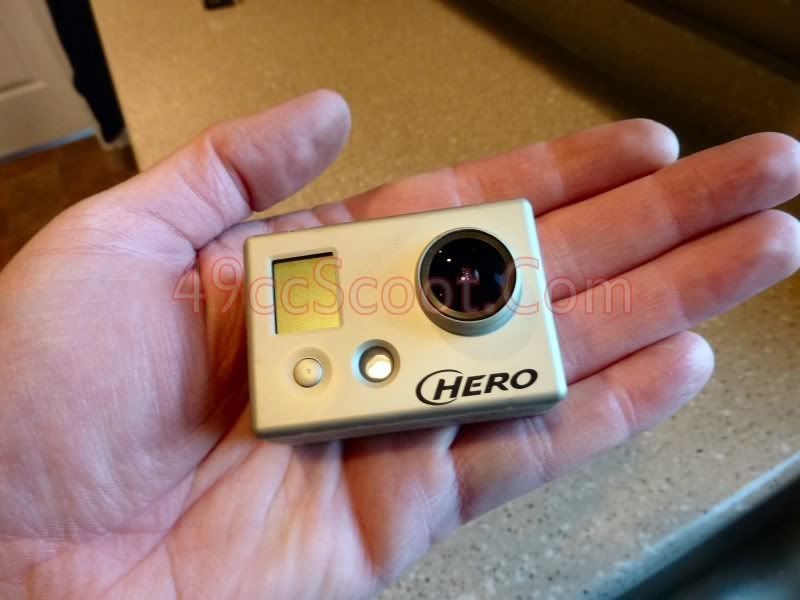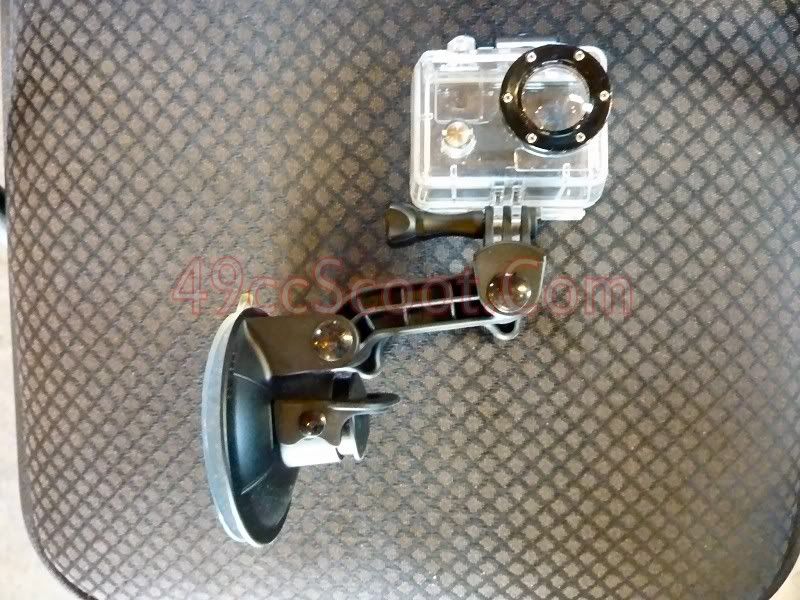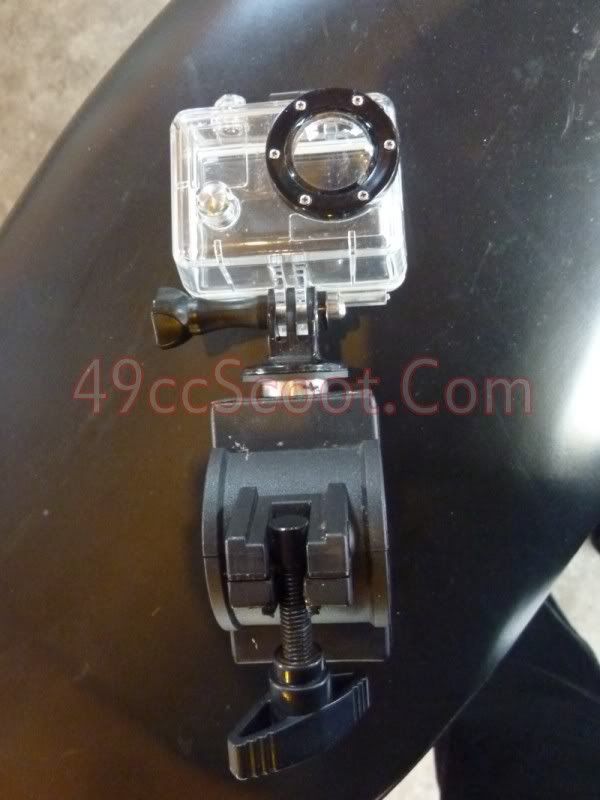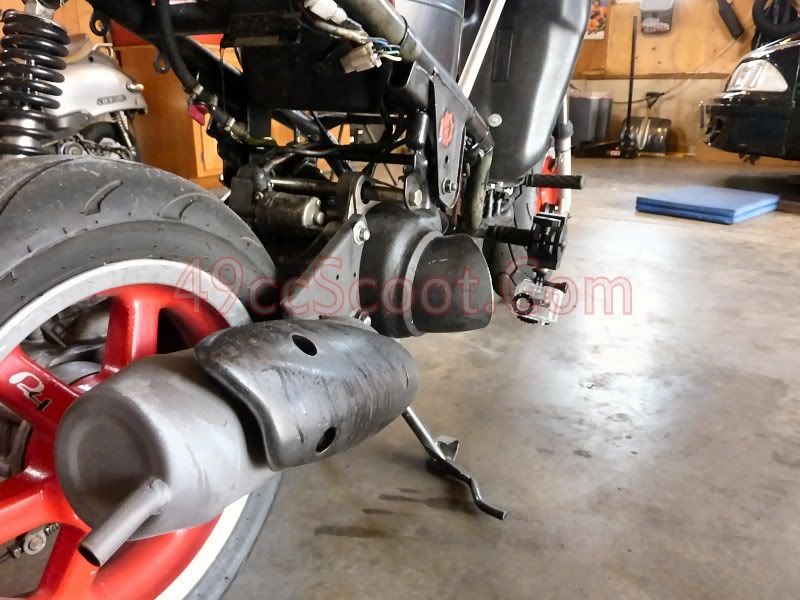Post by 90GTVert on Jan 11, 2012 14:11:20 GMT -5
I've been asked numerous times here and elsewhere about what I used or how I mounted my cam for different videos. None of my stuff is that great, but I figured I'd share it anyway. Maybe it will give someone an idea or help them make a cool vid. I encourage anyone else that films rides to share your setup, examples, and any tips and tricks if you have them.
I use a GoPro Hero HD. It's a very popular cam and shoots in 720p and 1080p HD. It can shoot 720p at up to 60 frames per second, or that and any other resolution at the standard 30fps. I can't say I see any difference for my vids at 60fps, but I haven't used it much. Filming at that rate consumes 2x the memory.

More info concerning the GoPro HD Hero (or the newest Hero 2) can be found at GoPro's site.
gopro.com/
It stores video on an SD card, up to 32GB. 32GB will hold many hours of HD footage, depending on what resolution and frame rate.
It has it's own internal battery that you can recharge via USB. You can get charging kits for home or 12 power as well. The battery lasts a little over 2hrs usually. For longer rides, you can use the 12V adapter for power.
One big advantage of this cam is that it's tiny. Here it is in the palm of my hand.

Another great thing is that it comes with a housing that allows it to be water proof and protects it from bugs, road debris, etc...


It comes with 2 different back plates for the housing. A solid one, obviously needed to be water proof, and one with openings. The one with openings is said to provide better sound for slower speeds. I always use the solid back. I found that I get too much wind noise with the open back, but where the cam is mounted could produce different results. There are now fur coverings for the open back plate that are said to almost eliminate wind noise at reasonable speeds while still allowing more sound to pass through than the solid back. (Available HERE.)

Another thing I have to mention is that the GoPro has a setting to allow you to film standard or upside down. You could always use video editing to flip a video, but with the GoPro there's no need, it does it for you. Set it in upside down mode and the vid comes out right side up when you mount the cam upside down. I have found this to be very useful.
GoPro cams are sold with just the bare minimums to get started or in kits. I chose the motorsports kit that included mounting solutions I thought would come in handy the most for my uses. The link below shows exactly what that kit includes.
gopro.com/cameras/hd-motorsports-hero-camera/
The big selling point of the motorsports pack for me was the suction cup mount.

It's got two adjustment points, plus you can add other adapters, so it could offer a lot of possibilities.

Here it is with the GoPro mounted to a side panel on the Venus.

As great as that looks like it would be, I can't seem to mount it any way I'd trust it on the scooter's panels. I did use it on one ride on a front panel and it held, but I could get the same view using other methods that were more stable. I've used it on a sportbike before and mounted to the side of a car and it held up well over 100MPH. I think the scooter's panels just aren't sturdy enough or flat in enough in many cases for it to work as it should. Here's an example of it on the fiberglass fairing of a CBR600RR.
The next option included in the motorsports kit (and others) are these mounting pads. They come in flat and curved bottoms with double-sided tape to allow them to mount to almost anything.


Those mounting pads allow you to clip in the actual mounts for the GoPro's housing or other accessories.



One of the most helpful bits of the kit is this adapter that allows you to extend a mount or make a 90 degree mount.

Here's a really simple mount that works pretty well. I just stuck a mounting pad on the top of my retro's headlight cover and used a simple straight up mount.


Here's a screenshot and video below as examples of what that produces.

Here I mounted the camera down low on the retro using a mounting pad and the 90 degree adapter. You could also turn that backwards for a rear view.


Here's a screenshot and video of what that mount captured.

Still another way to use the mounts and adapters in the motorsports kit is to put the cam on your helmet. Some stick it on the very top, but that creates a strange point of view IMO. I like it mounted on the side as shown below.



Here's a screenshot and vid from that mounting method.

I also picked up a roll bar mount from Eye Of Mine. It has adapters to mount on bars of varying sizes and can be coupled with other adapters to get different angles. It's just a simple clamp mount, so it installs very fast.


I mount it to my foot pegs facing forward or backward to produce different views. It can be turned so mount the cam higher or lower for a different effect as well.


Here are examples from this setup mounted facing forward.

Flip it around to face the other way for a totally different perspective.



The last way that I commonly mount my GoPro is just to tie it to the zipper of my riding jacket. I normally just use a couple of bread ties, but you can use whatever you like. There are chest mounts available that should give a similar view, but with more stability. As you'll see in the video example below, wind can catch the cam and move it around quite a bit just tied on.


Those are all of my goto mounting solutions for my GoPro, but the possibilities are seemingly endless with all the accessories available for it. Look through the link below for a lot more ideas...
www.eyeofmine.com/gopro/order-gopro-hero.html
I use a GoPro Hero HD. It's a very popular cam and shoots in 720p and 1080p HD. It can shoot 720p at up to 60 frames per second, or that and any other resolution at the standard 30fps. I can't say I see any difference for my vids at 60fps, but I haven't used it much. Filming at that rate consumes 2x the memory.

More info concerning the GoPro HD Hero (or the newest Hero 2) can be found at GoPro's site.
gopro.com/
It stores video on an SD card, up to 32GB. 32GB will hold many hours of HD footage, depending on what resolution and frame rate.
It has it's own internal battery that you can recharge via USB. You can get charging kits for home or 12 power as well. The battery lasts a little over 2hrs usually. For longer rides, you can use the 12V adapter for power.
One big advantage of this cam is that it's tiny. Here it is in the palm of my hand.

Another great thing is that it comes with a housing that allows it to be water proof and protects it from bugs, road debris, etc...


It comes with 2 different back plates for the housing. A solid one, obviously needed to be water proof, and one with openings. The one with openings is said to provide better sound for slower speeds. I always use the solid back. I found that I get too much wind noise with the open back, but where the cam is mounted could produce different results. There are now fur coverings for the open back plate that are said to almost eliminate wind noise at reasonable speeds while still allowing more sound to pass through than the solid back. (Available HERE.)

Another thing I have to mention is that the GoPro has a setting to allow you to film standard or upside down. You could always use video editing to flip a video, but with the GoPro there's no need, it does it for you. Set it in upside down mode and the vid comes out right side up when you mount the cam upside down. I have found this to be very useful.
GoPro cams are sold with just the bare minimums to get started or in kits. I chose the motorsports kit that included mounting solutions I thought would come in handy the most for my uses. The link below shows exactly what that kit includes.
gopro.com/cameras/hd-motorsports-hero-camera/
The big selling point of the motorsports pack for me was the suction cup mount.

It's got two adjustment points, plus you can add other adapters, so it could offer a lot of possibilities.

Here it is with the GoPro mounted to a side panel on the Venus.

As great as that looks like it would be, I can't seem to mount it any way I'd trust it on the scooter's panels. I did use it on one ride on a front panel and it held, but I could get the same view using other methods that were more stable. I've used it on a sportbike before and mounted to the side of a car and it held up well over 100MPH. I think the scooter's panels just aren't sturdy enough or flat in enough in many cases for it to work as it should. Here's an example of it on the fiberglass fairing of a CBR600RR.
The next option included in the motorsports kit (and others) are these mounting pads. They come in flat and curved bottoms with double-sided tape to allow them to mount to almost anything.


Those mounting pads allow you to clip in the actual mounts for the GoPro's housing or other accessories.



One of the most helpful bits of the kit is this adapter that allows you to extend a mount or make a 90 degree mount.

Here's a really simple mount that works pretty well. I just stuck a mounting pad on the top of my retro's headlight cover and used a simple straight up mount.


Here's a screenshot and video below as examples of what that produces.

Here I mounted the camera down low on the retro using a mounting pad and the 90 degree adapter. You could also turn that backwards for a rear view.


Here's a screenshot and video of what that mount captured.

Still another way to use the mounts and adapters in the motorsports kit is to put the cam on your helmet. Some stick it on the very top, but that creates a strange point of view IMO. I like it mounted on the side as shown below.



Here's a screenshot and vid from that mounting method.

I also picked up a roll bar mount from Eye Of Mine. It has adapters to mount on bars of varying sizes and can be coupled with other adapters to get different angles. It's just a simple clamp mount, so it installs very fast.


I mount it to my foot pegs facing forward or backward to produce different views. It can be turned so mount the cam higher or lower for a different effect as well.


Here are examples from this setup mounted facing forward.

Flip it around to face the other way for a totally different perspective.



The last way that I commonly mount my GoPro is just to tie it to the zipper of my riding jacket. I normally just use a couple of bread ties, but you can use whatever you like. There are chest mounts available that should give a similar view, but with more stability. As you'll see in the video example below, wind can catch the cam and move it around quite a bit just tied on.


Those are all of my goto mounting solutions for my GoPro, but the possibilities are seemingly endless with all the accessories available for it. Look through the link below for a lot more ideas...
www.eyeofmine.com/gopro/order-gopro-hero.html






